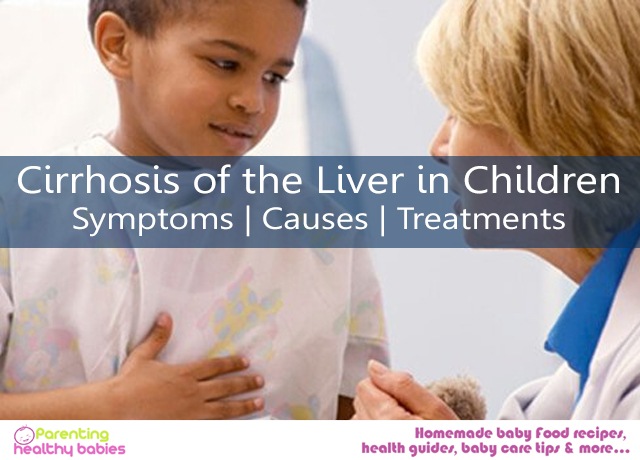Cirrhosis is the interstitial inflammation of the liver and has now become an exclusive disease among children. It is a chronic and irreversible disease that causes fibrosis and nodules between the cells of the liver, which causes changes in the structure of the liver and its functions since the circulation of blood is blocked. If the cirrhosis is very advanced, it can lead to liver failure or liver cancer.
Cirrhosis causes damage to the tissues of the liver, which means that the liver tissue is replaced by scar tissue or damaged tissue, and as a result, the liver stops functioning normally. As the liver and the body try to repair the damaged tissue, it is replaced by the formation of nodules in the body that are regenerative. All this leads to the fact that the liver loses its ability to function normally and alters the functions of the body.
Symptoms of Cirrhosis
The liver cirrhosis in children is characterized by injuries to organs and their structural elements. However, a large part of patients with cirrhosis do not show symptoms: they do not present clinical manifestations of liver damage or alterations. In these cases it is said that cirrhosis is compensated; that is, the body has found certain mechanisms to prevent the onset of symptoms due to liver failure. These compensation mechanisms are not totally beneficial for the patient since, in the long run; they are responsible for many complications of cirrhosis.
Liver cirrhosis in children can even be observed in newborn, which is associated with viral infections, carried on the mother during pregnancy.
The main symptoms of cirrhosis of the liver in children:
Among the signs and symptoms of newborn liver cirrhosis, especially noticeable is:
- Enlargement of the liver and spleen
- Jaundice and feces
- Presence of bruises and bleeding lesions on the face and trunk
- Sometimes bleeding from the remnants of the umbilical cord
Cirrhosis, in general, does not signal or have symptoms until the liver lesions become large. When there are signs and symptoms, these may include:
- Fatigue
- Bleeding with ease
- Prognosis to bruises
- Skin Itch
- Yellow discoloration of the skin and eyes (jaundice)
- Accumulation of fluid in the abdomen
- Loss of appetite
- Pigmentation in the stool
- Sickness
- Swelling in the legs
- Weight loss
- Confusion, drowsiness, and difficulty in speech (hepatic encephalopathy)
- Blood vessels in the form of spiders in the skin
- Redness in the palms of the hands
In advanced stages of the disease, more serious symptoms may also begin to appear, such as the National Institute of Diabetes and Digestive and Liver Diseases (NIDDK):
- Edema and ascites
- Bruising and frequent bleeding.
- Portal hypertension: An increase in blood pressure in the portal vein, which connects the intestines and the spleen with the liver.
- Appearance of esophageal varices and gastropathy.
- Splenomegaly
- Jaundice: Occurs when a diseased liver does not remove enough Bilirubin from the blood, which causes the skin and the whites of the eyes to assume a yellowish hue, as well as a darkening of the urine.
- Gallstones
- Greater sensitivity to medications
- Hepatic encephalopathy
- Type 2 diabetes: cirrhosis causes insulin resistance, which ends up causing an excess of glucose in the bloodstream.
- Liver cancer
Causes of Cirrhosis:
In general, cirrhotic patients are classified according to the degree of alteration of the liver and the cause that caused it (sometimes this will be unknown that is what in medicine is called ‘cryptogenic’ or ‘idiopathic’).
Liver cirrhosis has many causes. The most frequent among children are hepatitis C virus and hepatitis B virus. In some cases, patients have more than one triggering factor, so the appearance of cirrhosis is accelerated. In most cases, with an adequate study, it is possible to identify the causes of cirrhosis.
1} Hepatitis C virus
40% of cirrhotic patients have a chronic infection with this virus, which is demonstrated by the presence of specific antibodies (defenses produced by the body) or virus particles detected in the blood.
2} Hepatitis B virus
10% of patients with cirrhosis have a chronic infection with the B virus.
3} Auto-immune diseases
They appear when the body does not recognize some cells in our body and produces antibodies that destroy them as if they were foreign agents. If the cells that our body does not recognize are the liver cells it will produce auto antibodies (substances that ‘attack’ foreign agents) that will gradually destroy the liver cells.
4} The defects in the bile ducts
They are conduits that go picking up the bile that is produced in the liver and leading it towards the vesicle and the intestine. They can be obstructed by congenital problems. Both small and large pathways can become clogged. When they do small, cirrhosis can occur, being less frequent to occur if there is obstruction of large pathways. The latter usually leads to early symptoms that cause patients to be diagnosed and treated early, preventing the progression of the disease.
5} Cystic fibrosis
It is a hereditary disease by which some glands of our body are altered. Inflammation, including cirrhosis of the liver, may occur in some patients.
6} Hemochromatosis
Some children absorb more iron than necessary. This excess is deposited in different tissues of the body to which it is destroying. The liver is one of the organs that can be affected by this disease, leading to cirrhosis if it is not detected in time. It is a hereditary disease.
7} Wilson’s disease
Children who suffer from it absorb more copper than is necessary, and it is this metal that, when deposited in the liver, injures it. It is also a hereditary disease, so when an individual is diagnosed the other members of the family must be studied in order to start treatment before cirrhosis appears.
8} Drugs
In rare cases, the lesions produced in the liver by a drug are so serious that they can lead to cirrhosis. This can happen after severe hepatitis caused by a drug such as methotrexate (a drug used to treat some tumors), isoniazid, vitamin A in very high doses and some others.
Treatments
There is no treatment that is capable of completely eliminating cirrhosis, but interventions are usually carried out to alleviate the various symptoms:
Medications
can delay the progress of some types of cirrhosis or help relieve symptoms such as pain or fatigue.
Decrease blood pressure
This is achieved by stents (small cylindrical prostheses that are placed in the arterial walls) and can help alleviate problems of fluid retention or venous bleeding in the stomach and esophagus.
Improve the flow of bile
Through an endoscope, the bile ducts are stretched to extract the gallstones that obstruct the passage of bile.
Liver transplantation
In the more advanced stages of the disease, liver replacement can be considered.
8 Home remedies for cirrhosis of the liver
The home remedies ensure that one can keep the spread of cirrhosis in check as there is no way to reverse the effects of the diseases after they appear.
1. Eat papaya
Eating fresh fruits is a wonderful way to stay healthy and keep your body healthy inside. Papaya is a good home remedy for liver cirrhosis. The best way to prepare papaya to obtain direct benefits for the liver is the consumption of papaya juice. Take two tablespoons of this juice and add one or a half teaspoon of fresh lemon juice and drink this every day. If possible, do it 3 or 4 times a day for better results.
2. Natural yogurt and cumin:
Take two cups of water and add two spoons full of plain yogurt and 2 tablespoons cumin seeds. Add salt to taste. Basically, the idea is to make whey and take it twice a day. It is useful to maintain healthy levels of bacteria in the body relieve stomach aches and help with digestion.
3. Lemon
Take a glass of water, squeeze a lemon in it and add a little sea salt too. You must take it 3 times a day. Avoid sugar, since it is difficult to digest and is not easy to process for the liver already affected by cirrhosis. This mixture brings relief from the stomach problem and helps digestion. Lemon is good for digestion and also works as a natural laxative.
4. Spinach and Carrots
Carrots are rich in beta-carotene and spinach is a rich source of iron. Wash some carrots and a considerable amount of spinach leaves. Crush or grind and mix until a fine paste is obtained. Strain the mixture with a fine strainer and drink this juice to get some relief from the symptoms of liver cirrhosis and take care of your liver, at the same time you can provide the nutrients vital to the body.
5. Apple cider vinegar
Apple cider vinegar is good because it helps to improve the metabolism of fats. It also works as a good detoxifying agent for the liver. Take a glass of water and add a tablespoon of apple cider vinegar and a teaspoon of honey. Drink this mixture 3 times a day to get a healthy liver.
6. Amla:
Amla can be credited to your properties for health and the ability to keep the body healthy inside and out. The Indian gooseberry or amla as it is commonly known to most of us is an incredible ingredient to keep the liver damage in check.
Because amla is a rich source of vitamin C, its consumption maintains liver function correctly. Amla can be consumed in its preserved form. Another way is to get rid of the seed in the center of the fruit and grate it. Eat this grated amla with the salad or curd. If possible, chew a little to release the juice in the mouth and assimilate vitamin C faster in the body.
7. Make sure you consume turmeric
This is beneficial for the skin and internal organs; turmeric is a rich source of antiseptic, with anti-bacterial, anti-fungal, and antioxidant properties. Turmeric can do wonders for our liver and treat liver cirrhosis. There are many simple ways to consume turmeric, while the most common is its use in our daily kitchen.
Alternatively, we can use the old recipe of our mothers and grandmothers which consists of adding a spoonful of turmeric into a glass of warm milk and adding a little honey to it. This is also a great way to consume it. Turmeric takes care of the liver and keeps the body’s free radicals before they can cause any damage or harm.
8. Flax seeds:
Flax seeds have emerged in recent times as a final participant in the career of health benefits. Flax seeds may not directly benefit the liver cirrhosis condition but may help reduce the burden on the liver that is already suffering. Flax seeds are rich in phytonutrients and these phytonutrients help prevent the unwanted excess of circulating hormones in the blood. There are many ways to eat flax seeds.
They can be added to salads and sandwiches after roasting a little and alternatively many people are using them in shakes and smoothies on a daily basis. You can also eat simply roasted and directly receive a bit of these seed every day, early in the morning on an empty stomach to get better results.
References:
http://www.chp.edu/our-services/transplant/liver/education/liver-disease-states/cirrhosis













